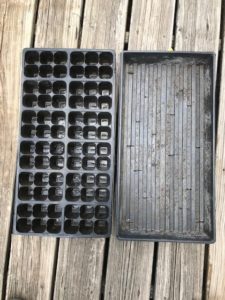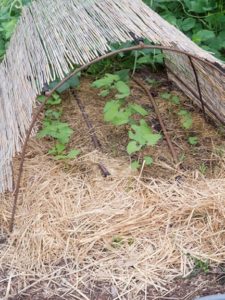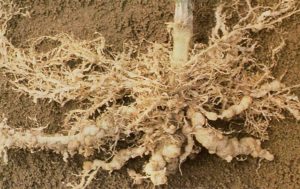Stay Hydrated and Keep Gardening!

Even Okra wilts in the August vegetable garden.
I’m not going to lie. I lose the will to garden in the August vegetable garden. I’m out of rainwater, the heat is relentless, and the last thing I want to do is battle the sun to save some seedlings. But somehow, I bully myself into doing it anyway, and it’s a good thing. If you wait until the weather is easier to deal with, you will be out of luck for fall gardening.
Last Call for Warm Season Vegetable Starts
The first of August is the last window for planting warm season crops like squash, corn, cucumbers, and green beans if you want a harvest before frost. Here in Austin our last frost date is usually the first week of December, although it has arrived as early as Halloween.

Seed your vegetables in individual cells or in a single tray. Either way you’ll need to transplant into larger pots once they have at least two true leaves.
Trying to keep things alive right now is a challenge, but there are a couple of strategies to try. One is to keep seedlings in the house for as long as possible. If you’ve got grow lights or an especially bright area in front of a patio door or large window, this might be an option. Outside, shade cloth can help save young plants. Just be sure that you’ve got plenty of ventilation or you will create a greenhouse effect. I like to use shade cloth only on the west side of the bed so that I get plenty of air circulation but protect the plants from the brutish afternoon sun.
Inspect for Disease in the August Vegetable Garden
Now is a good time to check for root knot nematodes. In general, I prefer not to disturb the soil in my vegetable beds because I want to preserve the fungal networks attached to the roots. However, I have a problem with root knot nematodes, so I make a slight exception.
I check each of my garden beds by pulling up two to three plants to check their roots. I’m looking for the telltale signs of gnarled, lumpy roots that indicate the root knot nematodes are present. If they are, that helps me decide my crop rotation plan. Grasses are one plant that nematodes infect but can’t reproduce in. So, if it’s August, I plant sweet corn. I’ll follow up with a winter sowing of Elbon cereal rye too for good measure. Elbon is a Southern type of cereal rye developed by the Oklahoma Agricultural Experiment Station.
Another Pitch for Crop Rotation
Crop rotation is a proven technique to help maintain soil health from pests/disease build up and from depleting specific micronutrients. For a deep dive into this subject, visit this article Vegetable Rotations-Successions and Intercropping by Roland E. Roberts, Extension Vegetable Specialist. I also saw recently a simple four-year rotation that you can try. First you divide your garden bed or area into four sections. Then plant the following families in rotation:
| Year 1 | Section 1 | Nightshade family (potatoes, tomatoes, peppers, eggplant) |
| Section 2 | Legumes (beans, peas, or summer vetch cover crop) or onions and roots (carrots, beets, sweet potatoes) | |
| Section 3 | Brassicas (kales, broccoli, collards or turnips) | |
| Section 4 | Grasses (corn, Elbon rye winter cover crop) or squash | |
| Year 2 | Section 1 | Legumes (beans, peas, or summer vetch cover crop) or onions and roots (carrots, beets, sweet potatoes) |
| Section 2 | Brassicas (kales, broccoli, collards or turnips) | |
| Section 3 | Grasses (corn, Elbon rye winter cover crop) or squash | |
| Section 4 | Nightshade family (potatoes, tomatoes, peppers, eggplant) | |
| Year 3 | Section 1 | Brassicas (kales, broccoli, collards or turnips) |
| Section 2 | Grasses (corn, Elbon rye winter cover crop) or squash | |
| Section 3 | Nightshade family (potatoes, tomatoes, peppers, eggplant) | |
| Section 4 | Legumes (beans, peas, or summer vetch cover crop) or onions and roots (carrots, beets, sweet potatoes) | |
| Year 4 | Section 1 | Grasses (corn, Elbon rye winter cover crop) or squash |
| Section 2 | Nightshade family (potatoes, tomatoes, peppers, eggplant) | |
| Section 3 | Legumes (beans, peas, or summer vetch cover crop) or onions and roots (carrots, beets, sweet potatoes) | |
| Section 4 | Brassicas (kales, broccoli, collards or turnips) |
August Vegetable Garden Checklist
Here are some other items that you can add to your August Vegetable Garden Checklist.
Fertilizer
- Keep your peppers and eggplant growing strong with a regular supply of moisture and a dose of water-soluble fertilizer every two weeks; they love fall weather and will produce right up until frost.
Water and Irrigation
- Fruiting crops like okra, pumpkins, eggplant and Southern peas need a dependable supply of moisture, especially during flowering and fruit enlargement in order to develop properly.
- Irrigate in the morning. Wilted plants in the afternoon is a natural response. Watering at night in times of high humidity can promote fungal disease.
Planting
- Plant your favorite varieties of green beans, cucumbers, and squash later this month. It’s best to stick with varieties that produce in 60 days or less. This information should be on the seed pack-et or catalog description.
- Plant seeds for brassicas, Swiss chard and other fall vegetables in small pots indoors under grow lights or outside in a bright shady spot. Seedlings will be transplant size in about 6 weeks. Extend your harvest by planting a few seeds a week or so apart so that plants will mature at different times.
Soil
- Mulch well to inhibit weed germination and conserve precious moisture.
- Re-start the compost pile so you’ll have plenty of finished compost next month for fall gardening, or research soil yards for best compost to purchase.
Diseases and/or Pests to Look For
- Remove any spent or diseased plants in preparation for fall planting. Check the roots to see if root knot nematodes were a contributing factor.
- Even though it’s hot, Inspect the garden on a regular basis, keeping an eye out for damaging pests who don’t slow down in the summer.
Maintenance
- Thin plants to the proper spacing once they are up and growing; crowded plants rarely reach their production potential and compete for moisture
- Provide shade for young plants. Provide plenty of air movement to prevent.

Master Gardener Patty Leander likes using bamboo fencing for shade cover.
Harvest
- Harvest herbs for use in the kitchen. Prune lightly to encourage new growth. I really like herb infused water or herbs in my ice cubes.
- Keep up with Okra harvesting and don’t let those pods develop into cruise missiles
Additional Resources
Watch the Vegetable Gardening in Central Texas Webinar
Vegetable Planting Calendar (English) (Español) (繁体中文)
Recommended Vegetable Varieties for Travis County
Plant Rotations, Successions and Intercropping
Monthly Gardening Calendar for Austin and Central Texas
About Sheryl Williams
 Sheryl Williams has been a Travis County Master Gardener since 2010 and currently works as the Horticulture Program Assistant at Texas A&M AgriLife Extension – Travis County. She was introduced to gardening by her mom and grandma and has been an avid vegetable gardener most of her life. Sheryl believes that there is nothing more satisfying than growing and preparing your own food. She likes gardening in Austin year round and concedes that means pulling weeds every day. She practices organic gardening principles and enjoys the challenge of outsmarting garden pests. Occasionally she loses these battles, but doesn’t mind sharing a good meal.
Sheryl Williams has been a Travis County Master Gardener since 2010 and currently works as the Horticulture Program Assistant at Texas A&M AgriLife Extension – Travis County. She was introduced to gardening by her mom and grandma and has been an avid vegetable gardener most of her life. Sheryl believes that there is nothing more satisfying than growing and preparing your own food. She likes gardening in Austin year round and concedes that means pulling weeds every day. She practices organic gardening principles and enjoys the challenge of outsmarting garden pests. Occasionally she loses these battles, but doesn’t mind sharing a good meal.


